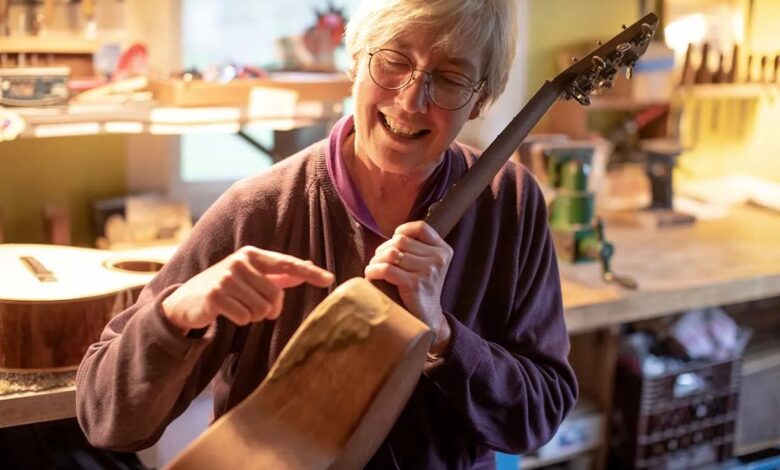Cat Fox of Sound Guitar Repair Fixes and Restores Instruments for Stars and Hobbyists Alike

In the early 1980s Cat Fox, disillusioned by a year of studying management and aviation at Central Washington University, felt that something was missing. She went for a long drive in her Volkswagen bus along the windy roads of eastern Washington to clear her head and had an epiphany. “I thought, I like to party, I like to hang out with musicians, and I like to work with wood,” Fox recalls. “So, it was either be a groupie, which I thought would be short lived, or make guitars.”
Fox pulled over in the first big town she came to, which was Missoula, Montana, and went into a guitar store. There, she asked the repair guy how he learned his trade. He told her he had attended Minnesota State College Southeast in Red Wing, and so Fox applied, was accepted, and transferred right away. After graduating, she apprenticed with renowned luthier William Cumpiano, author of the seminal book Guitarmaking: Tradition and Technology, before opening her own shop, Sound Guitar Repair, in Seattle in 1989.
Fox recently relocated to South Hero, Vermont, to be with her husband, retired luthier Rick Davis of Running Dog Guitars. It’s taken a few years to get settled, but her business is once again thriving. With decades of experience under her belt, Fox has become a trusted name among musicians—among her clients over the years are the Everly Brothers, Roseanne Cash, and Bill Frisell.
I recently spoke with Fox from her workshop via Zoom about her training, memorable repair jobs, and her recent move to New England. Always smiling and quick with a laugh, her kindness shines as brightly as her impeccable work.
What was it like being a student at Red Wing?
It was great, actually. Red Wing was very nurturing. We had a really good professor, and the class was about one-third women, two-thirds guys, all ages. We all got along really well.
How did your apprenticeship with William Cumpiano come about?
My boyfriend at Red Wing and I both sent out tons of resumes and cover letters. I only got one response. It was basically, “Dear Cat: There’s no future in guitars. Go into computers.” I wish I had kept that and framed it, but I just threw it away. So there was a bit of sexism in the industry.
My boyfriend got a bunch of responses but ended up going and working at Elderly Instruments, who needed another repair person. And so I said, “Well, do you think I could send something to these people who responded to you positively?” And he’s like, “Yeah, go ahead.” So, I mailed a letter to William Cumpiano asking if he’d take me on as an apprentice instead of my boyfriend. He was like, ‘Well, no guarantees. You know, I’d have to meet you and see your work.’ And so I thought, Well, of course he’s going to like me, and my work is pretty good. So, I just packed up my Volkswagen and went to Massachusetts, where I had never been before.
That’s some trust. How did things turn out?
I was with him for six years−I was his apprentice for two of those years and then I became his repair person. I was also building guitars that went out under his name, but I didn’t get any credit for that. There’s a little blurb in the front of his book that says, “Thank you, Cat Fox, for all of your help.” But as much as I had to do a lot of “smile and nod, girls, smile and nod,” I got a lot out of it; I got to meet a lot of people, and it was really great. When I decided to go out to Seattle, I felt pretty assured I could start a business and do okay.
Where did the name of your business, Sound Guitar, come from?
So there’s the Puget Sound, sound [cups her ears], and also sound as in soundhole. It’s always funny when people say, “That’s a two-way pun,” and I say, “three-way, actually.”
Do you mostly do repairs, or do you build guitars too?
I did a lot of building at Bill’s shop. Sound Guitar Repair started as basically a repair shop, and it was for years and years. And then Rick [Davis], who’s my husband, came out to Seattle and we moved to the Fremont neighborhood and started a really large shop. It was 1,700 square feet, and we had a whole building studio. We had benches for students, and I had my repair studio in there. It was a full-service kind of deal where you could commission a guitar, learn how to build, or get your Martin fixed.
How is your business going after relocating to Vermont?
When I got here six years ago, I was really helped out by Adam Buchwald of Circle Strings and Iris Guitars, who is awesome. He gave me all the work I could do instantly when I hit town. I didn’t even have my shop set up. So, I give a lot of thanks to Adam. But of course, as time went on, he hired people of his own. I do very little of Adam’s work now, but people do still send me things from around the United States, and every local person has discovered me as well. I’m getting people from upstate New York, Canada, and all around Vermont. I just had a guy from Boston drive all the way up here. Yay for that! I can’t complain.
I love that you say your shop is a “no-kill shelter for vintage guitars.” We keep hearing more and more about people’s guitars being damaged in air transit, sadly, so your motto is really resonant.
Well, that’s kind of what I’ve been doing my whole career. Has your Martin been run over by a truck? I can resurrect it!
What’s the hardest repair you’ve ever done?
Actually the guy with the Martin. He ran over it with his own truck! He was loading his truck and he put it on the wheel well and then he forgot about it and backed over it. It just sat in his closet for 20 years because he could not deal with it. But he finally brought it in, and we put it back together for him. That was the hardest repair I’ve ever done. I’ve done some really involved repairs, but putting a Martin back together from splinters… Luckily for me, the splinters were all there.

Do you work on electric as well as acoustic instruments?
I do just about everything with frets, and I also work on ouds because I became the darling of the Turkish and Egyptian communities in Seattle. There’s an old guy called Maurice Rouman, Master of the Oud, as it says on his business card, and he would just bring me ouds like bouquets. He’d have three in each hand, and he’d walk in and say, “Madame, I have many, many ouds for you.”
Wow. So, that has to be a different repair process because of the rounded back.
It is so different. There are no frets, and the construction is typically unrefined. So Maurice Rouman, this tiny 90-year-old, half-blind Egyptian guy, taught me everything I know about oud repair.
Is there a type or brand of instrument that you would love to work on that you haven’t before?
I’ve worked on just about everything—even three Lloyd Loar [1920s Gibson] mandolins. Those are the pinnacle of everything.
Were you nervous to work on those?
Oh my God, yes. I’ve got this thing, it’s as expensive as your house, right? So, I’m like, what do I do with this? Take it home and sleep with it? What if my house gets broken into? What if I put it under my bed and something happens? So I would carry them around with me and just stress out. But I got them all done and everything was fine. Those were probably the most famous instruments to work on, and the most nerve wracking. I also fixed those iconic black [Gibson] Everly Brothers guitars. That was a big deal, too.
What other musicians’ guitars have you enjoyed working on?
I worked on Richard Shindell’s guitar, and he’s a huge favorite. Another was Cris Williamson. I grew up listening to her, and then in Seattle about 20 years ago, I answered the phone and this woman says, “Hi, this is Cris Williamson,” and I said, “Shut up!” [laughs] Her guitar had been damaged by the airlines. So, I got to meet Cris Williamson, who is as awesome as you’d hope she would be. Rosanne Cash—I got to fix her guitar. That was amazing; she’s just so down to earth. Those are some of my idols; I actually got to work on their stuff, and that was so exciting.
Do you get nervous in general or just for these expensive and/or famous instruments?
Not really. There are guitars that I work on on the regular that are worth $20,000, which is not an insubstantial amount of money—if I were to drop a chisel on top or something.
Have you ever done that?
No comment [laughs]. Part of being a really good repair technician is that you learn how to fix your mistakes.
Can you tell me about fixing one of these so-called mistakes?
Once I was working on a guitar that was signed by Janis Ian. It was kind of filthy, and I was trying to clean it really carefully around the signature and ended up taking the J off of the Janis, so it read “anis Ian” [laughs]. I went to my local art store and got all of the gold Sharpies, then practiced my J so I could do one as close to Janis Ian’s as possible. Somehow the customer never noticed.
So you need to be good at fixing your mistakes. Is there another mission statement you can think of that’s a guide for you?
Another mission statement is something along the lines of “Fake it till you make it,” but not quite. Sometimes you want to at least give the aura of competency. And then once the customer is out the door, you start calling up your luthier friends. I have a great network of people whose advice I trust, and I’m on the phone with them a lot. And it works both ways. It’s nice to know that there are other people, because there are an awful lot of guitars out there and they all have different stuff going on. You’re confronted with a 1949 Gibson and you’re like, Does this one have the top that goes over the joint so you can’t get the neck off? And then you’re like, Dammit. I didn’t charge enough for that!
Do you go to workshops and conferences to keep up with the latest lutherie and repair techniques?
I used to go to every conference, but I’ve gotten away from it now that I’m sort of winding down.
Are you really winding down?
Yes. I’m 63 and am getting a little arthritis. My eyes aren’t as good as they were. There’s a day when my work is going to start deteriorating, and I hope to God I realize that before I start getting bad because one of my biggest fears is people saying, “Cat used to be good.” I don’t want that to happen—I want to end at a good point.



